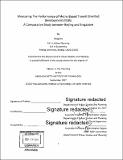| dc.contributor.advisor | P. Christopher Zegras. | en_US |
| dc.contributor.author | Xie, Yiling, M.C.P. Massachusetts Institute of Technology | en_US |
| dc.contributor.other | Massachusetts Institute of Technology. Department of Urban Studies and Planning. | en_US |
| dc.coverage.spatial | a-cc-pe a-si--- | en_US |
| dc.date.accessioned | 2018-02-16T20:06:28Z | |
| dc.date.available | 2018-02-16T20:06:28Z | |
| dc.date.copyright | 2017 | en_US |
| dc.date.issued | 2017 | en_US |
| dc.identifier.uri | http://hdl.handle.net/1721.1/113803 | |
| dc.description | Thesis: M.C.P., Massachusetts Institute of Technology, Department of Urban Studies and Planning, 2017. | en_US |
| dc.description | Cataloged from PDF version of thesis. | en_US |
| dc.description | Includes bibliographical references (pages 97-101). | en_US |
| dc.description.abstract | Transit oriented Developments (TOD) is a package that consists of urban form and development strategies that aims to foster efficient land use patterns to create sustainable neighborhoods. By using public transit as a focal point to create attractive environments, TOD is a promising approach to tackle urban issues such as traffic congestion, ineffective land use, and air pollution in metropolises like Beijing. Beijing, and even the entire country of China, is at its 'Golden Age' of metro system expansion. As metro systems have the capacity to reshape urban mobility and urban form, they are considered one of the key components for TOD and thus pose transformational opportunities for cities to embrace better TOD. Yet to provide suggestions to future TOD implementation, we need to first evaluate the performance of existing TOD, including outputs and outcomes of TOD. This thesis examines TOD in the Chinese context, specifically, Beijing, and compares it to Singapore, a well-recognized TOD city in Asia with comparable density to Beijing. In this thesis, I see the outputs of TOD as a spectrum of built environment indicators that characterize TOD, and the outcome of TOD as increased metro ridership. I constructed a TOD evaluation framework that contains indicators of density, diversity, design and connectivity and measures the TOD-ness of metro station area. I find that Singapore has an overall higher TOD score across its MRT station areas than Beijing, with both cities displaying better TOD-ness in the inner city areas. Yet the spatial distribution of TOD-ness is more monocentric in Singapore in the design, diversity and connectivity dimensions. I then used the TOD indicators and station-level ridership to estimate direct ridership models for both cities. I find evidence that built environment indicators, such as population density, ground-floor retail density and number of metro entrances, are positively associated with ridership. The Singapore models, overall, have a better fit than the Beijing models. I conclude by summarizing the work, identifying some challenges to improving TOD performance in Beijing, and identifying areas for future work. Keywords: Transit oriented Developments, Beijing, Singapore, built environment, indicator framework, metro station, ridership. | en_US |
| dc.description.statementofresponsibility | by Yiling Xie. | en_US |
| dc.format.extent | 126 pages | en_US |
| dc.language.iso | eng | en_US |
| dc.publisher | Massachusetts Institute of Technology | en_US |
| dc.rights | MIT theses are protected by copyright. They may be viewed, downloaded, or printed from this source but further reproduction or distribution in any format is prohibited without written permission. | en_US |
| dc.rights.uri | http://dspace.mit.edu/handle/1721.1/7582 | en_US |
| dc.subject | Urban Studies and Planning. | en_US |
| dc.title | Measuring the performance of metro-based Transit Oriented Development (TOD) : a comparative study between Beijing and Singapore | en_US |
| dc.type | Thesis | en_US |
| dc.description.degree | M.C.P. | en_US |
| dc.contributor.department | Massachusetts Institute of Technology. Department of Urban Studies and Planning | |
| dc.identifier.oclc | 1022949009 | en_US |
